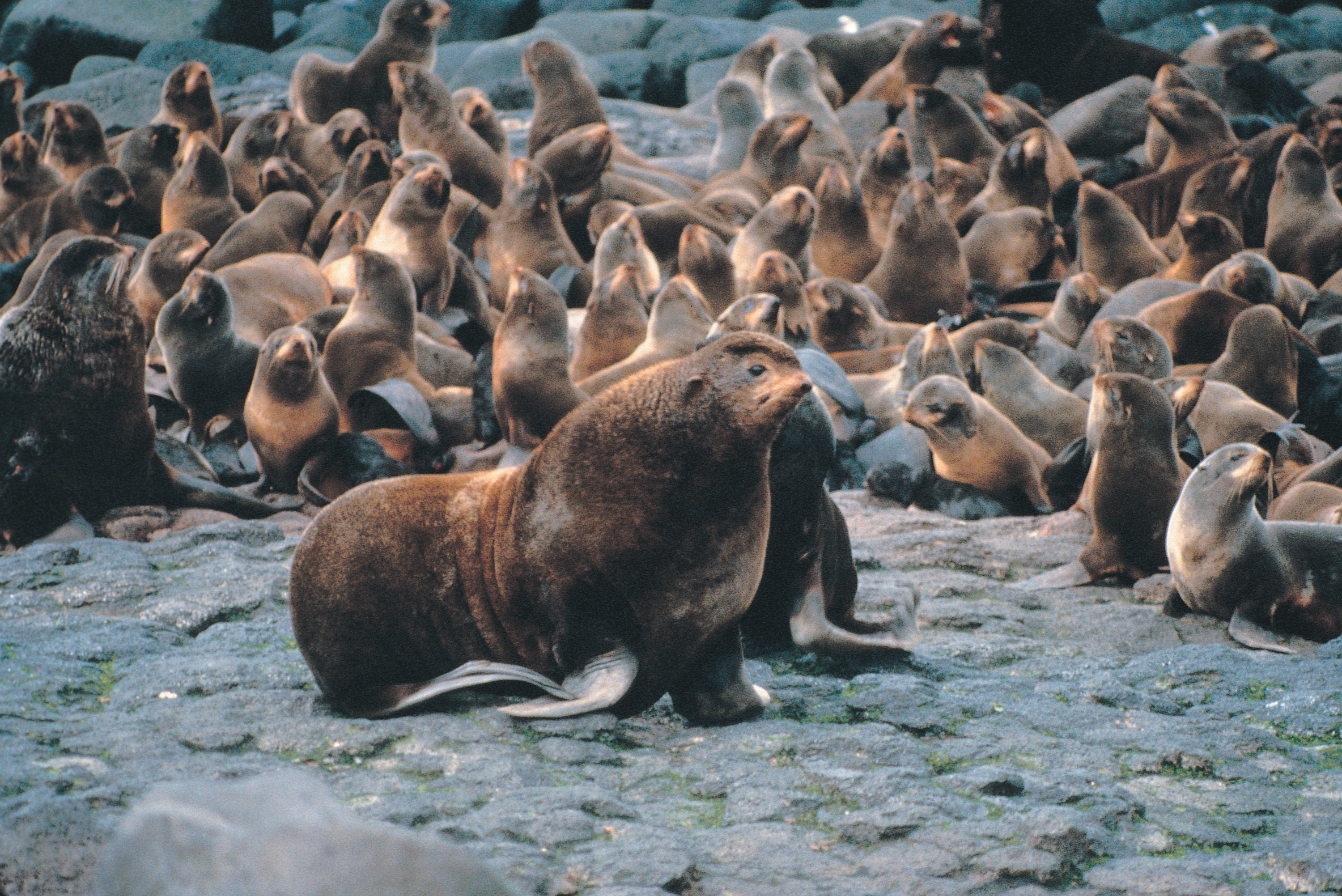|
Mate Choice Copying
Mate-choice copying, or non-independent mate choice, occurs when a female of an animal species copies another fellow female's mate choice. In other words, non-independent mate-choice is when a female's sexual preferences get socially inclined toward those of their fellow females. This behavior is speculated to be one of the driving forces of sexual selection and the evolution of male traits. It is also hypothesized that mate-choice copying can induce speciation due to the selective pressure for certain, preferred male qualities. Moreover, mate-choice copying is one form of social learning in which animals behave differently depending on what they observe in their surrounding environment. In other words, the animals tend to process the social stimuli they receive by observing the behavior of their conspecifics and execute a similar behavior to what they observed. Mate choice copying has been found in a wide variety of different species, including (but not limited to): invertebrates, ... [...More Info...] [...Related Items...] OR: [Wikipedia] [Google] [Baidu] |
Game Theory
Game theory is the study of mathematical models of strategic interactions among rational agents. Myerson, Roger B. (1991). ''Game Theory: Analysis of Conflict,'' Harvard University Press, p.&nbs1 Chapter-preview links, ppvii–xi It has applications in all fields of social science, as well as in logic, systems science and computer science. Originally, it addressed two-person zero-sum games, in which each participant's gains or losses are exactly balanced by those of other participants. In the 21st century, game theory applies to a wide range of behavioral relations; it is now an umbrella term for the science of logical decision making in humans, animals, as well as computers. Modern game theory began with the idea of mixed-strategy equilibria in two-person zero-sum game and its proof by John von Neumann. Von Neumann's original proof used the Brouwer fixed-point theorem on continuous mappings into compact convex sets, which became a standard method in game theory and mathema ... [...More Info...] [...Related Items...] OR: [Wikipedia] [Google] [Baidu] |
Nuptial Gift
A nuptial gift is a nutritional gift given by one partner in some animals' sexual reproduction practices. Formally, a nuptial gift is a material presentation to a recipient by a donor during or in relation to sexual intercourse that is not simply gametes in order to improve the reproductive fitness of the donor. Often, such a gift will improve the fitness of the recipient as well. This definition implies neutral gifts, costly gifts and beneficial gifts regarding the fitness of the recipient. Nuptial gifting is at the intersection of sexual selection, nutritional ecology, and life history theory, creating a link between the three. Edible and inedible nuptial gifts Many nuptial gifts are a source of nutrition for the recipient. In many species of animals, including birds, insects, and spiders, this takes the form of a food item that is transferred from a male to a female just prior to copulation. This is a behavior known as courtship feeding. Inedible tokens may include items ... [...More Info...] [...Related Items...] OR: [Wikipedia] [Google] [Baidu] |
Harem (zoology)
A harem is an animal group consisting of one or two males, a number of females, and their offspring. The dominant male drives off other males and maintains the unity of the group. If present, the second male is subservient to the dominant male. As juvenile males grow, they leave the group and roam as solitary individuals or join bachelor herds. Females in the group may be inter-related. The dominant male mates with the females as they become sexually active and drives off competitors, until he is displaced by another male. In some species, incoming males that achieve dominant status may commit infanticide. For the male, the primary benefit of the harem system is obtaining exclusive access to a group of mature females. The females benefit from being in a stable social group and the associated benefits of grooming, predator avoidance and cooperative defense of territory. The disadvantages for the male are the energetic costs of gaining or defending a harem which may leave him with r ... [...More Info...] [...Related Items...] OR: [Wikipedia] [Google] [Baidu] |
Fallow Deer
''Dama'' is a genus of deer in the subfamily Cervinae, commonly referred to as fallow deer. Name The name fallow is derived from the deer's pale brown colour. The Latin word ''dāma'' or ''damma'', used for roe deer, gazelles, and antelopes, lies at the root of the modern scientific name, as well as the German ''Damhirsch'', French ''daim'', Dutch ''damhert'', and Italian ''daino''. In Croatian and Serbian, the name for the fallow deer is ''jelen lopatar'' ("shovel deer"), due to the form of its antlers. The Modern Hebrew name of the fallow deer is ''yachmur'' (יחמור). Taxonomy and evolution The genus includes two extant species: Extant species Some taxonomists include the Persian fallow deer as a subspecies In biological classification, subspecies is a rank below species, used for populations that live in different areas and vary in size, shape, or other physical characteristics (morphology), but that can successfully interbreed. Not all species ... (''D. d. me ... [...More Info...] [...Related Items...] OR: [Wikipedia] [Google] [Baidu] |
Biotic Component
An ecosystem (or ecological system) consists of all the organisms and the physical environment with which they interact. These biotic and abiotic components are linked together through nutrient cycles and energy flows. Energy enters the system through photosynthesis and is incorporated into plant tissue. By feeding on plants and on one another, animals play an important role in the movement of matter and energy through the system. They also influence the quantity of plant and microbial biomass present. By breaking down dead organic matter, decomposers release carbon back to the atmosphere and facilitate nutrient cycling by converting nutrients stored in dead biomass back to a form that can be readily used by plants and microbes. Ecosystems are controlled by external and internal factors. External factors such as climate, parent material which forms the soil and topography, control the overall structure of an ecosystem but are not themselves influenced by the ecosystem. Interna ... [...More Info...] [...Related Items...] OR: [Wikipedia] [Google] [Baidu] |
Abiotic Component
In biology and ecology, abiotic components or abiotic factors are non-living chemical and physical parts of the environment that affect living organisms and the functioning of ecosystems. Abiotic factors and the phenomena associated with them underpin biology as a whole. They affect a plethora of species, in all forms of environmental conditions, such as marine or land animals. Humans can make or change abiotic factors in a species' environment. For instance, fertilizers can affect a snail's habitat, or the greenhouse gases which humans utilize can change marine pH levels. Abiotic components include physical conditions and non-living resources that affect living organisms in terms of growth, maintenance, and reproduction. Resources are distinguished as substances or objects in the environment required by one organism and consumed or otherwise made unavailable for use by other organisms. Component degradation of a substance occurs by chemical or physical processes, e.g. hydroly ... [...More Info...] [...Related Items...] OR: [Wikipedia] [Google] [Baidu] |
Deception Hypothesis
Deception or falsehood is an act or statement that misleads, hides the truth, or promotes a belief, concept, or idea that is not true. It is often done for personal gain or advantage. Deception can involve dissimulation, propaganda and sleight of hand as well as distraction, camouflage or concealment. There is also self-deception, as in bad faith. It can also be called, with varying subjective implications, beguilement, deceit, bluff, mystification, ruse, or subterfuge. Deception is a major relational transgression that often leads to feelings of betrayal and distrust between relational partners. Deception violates relational rules and is considered to be a negative violation of expectations. Most people expect friends, relational partners, and even strangers to be truthful most of the time. If people expected most conversations to be untruthful, talking and communicating with others would require distraction and misdirection to acquire reliable information. A significant amount ... [...More Info...] [...Related Items...] OR: [Wikipedia] [Google] [Baidu] |
Poecilia Mexicana
''Poecilia mexicana'', commonly known as the shortfin molly or Atlantic molly, is a species of poeciliid fish native to fresh and brackish water in Mexico and Guatemala. One population is found in caves and known as the cave molly. Description The maximum standard length of this fish is . It typically grows to a total length . Distribution and habitat The fish lives in tropical freshwater and brackish water habitats. The shortfin molly is considered benthopelagic. It lives in a pH range between 7.0 and 7.5 at temperatures between 22 and 28 degrees Celsius. The species does not migrate. It is an invasive species in the Muddy River of Nevada, USA. Ecology Speciation In two case studies in Cueva del Azufre and Cueva Luna Azufre in Tabasco, Mexico, the Atlantic molly is experiencing speciation. It is occurring between cave and surface populations as well as between habitats of varying sulfur concentrations. Human significance The fishing industry has no interest in harvesting ... [...More Info...] [...Related Items...] OR: [Wikipedia] [Google] [Baidu] |
Sailfin Molly
The sailfin molly (''Poecilia latipinna'') is a species of fish of the genus ''Poecilia''. They inhabit fresh, brackish, salt, and coastal waters from North Carolina to Texas and the Yucatán Peninsula of Mexico. Taxonomy The sailfin molly was originally described in 1821 as ''Mollienesia latipinna'' by the naturalist Charles Alexandre Lesueur, who based his description upon specimens from freshwater ponds in the vicinity of New Orleans, Louisiana. However, Lesueur described other collections of the sailfin molly as ''Mollienesia multilineata'' in 1821, the same year in which he described ''M. latipinna''. This conflict created confusion and eventually necessitated a ruling by the International Commission on Zoological Nomenclature (ICZN). In 1959, the ICZN placed precedence on the name ''Mollienesia latipinna'' Lesueur 1821. In a landmark definitive work on poeciliid fishes, Donn Rosen and Reeve Bailey (1959) noted the priority of ''Poecilia'' by Marcus Elieser Bloch and Johann ... [...More Info...] [...Related Items...] OR: [Wikipedia] [Google] [Baidu] |
Cryptic Female Choice
Cryptic female choice is a form of mate choice which occurs both in pre and post copulatory circumstances when females in certain species use physical or chemical mechanisms to control a male's success of fertilizing their ova or ovum; i.e. by selecting whether sperm are successful in fertilizing their eggs or not. It occurs in internally-fertilizing species and involves differential use of sperm by females when sperm are available in the reproductive tract. The present understanding of cryptic female choice is largely thanks to the extensive research and analysis done by William G. Eberhard. The term ‘cryptic’ according to Eberhard is meant to describe an internal and thereby hidden choice some female organisms are able to make following insemination with regards to sperm selection. In male species with intromittent organs, during copulation, a male inserts his reproductive organ into that of a female's so as to inseminate her with his genetic material. Through the developmen ... [...More Info...] [...Related Items...] OR: [Wikipedia] [Google] [Baidu] |
Poecilia Latipinna
''Poecilia'' is a genus of fishes in the family Poeciliidae of the order Cyprinodontiformes. These livebearers are native to fresh, brackish water, brackish and salt water in the Americas, and some species in the genus are euryhaline. A few have adapted to living in waters that contain high levels of toxic hydrogen sulfide ()Palacios, Arias-Rodriguez, Plath, Eifert, Lerp, Lamboj, Voelker, & Tobler (2013). The Rediscovery of a Long Described Species Reveals Additional Complexity in Speciation Patterns of Poeciliid Fishes in Sulfide Springs.' PLoS ONE 8(8): e71069. and a population of ''Poecilia mexicana, P. mexicana'' lives Cavefish, in caves (other populations of this species are surface-living). Some common and widespread species are often kept as live-bearing aquarium fish, aquarium fish, while other have very small ranges and are seriously Threatened species, threatened. All species in ''Poecilia'' are called mollies except for the Endler's livebearer (''P. wingei'') and the we ... [...More Info...] [...Related Items...] OR: [Wikipedia] [Google] [Baidu] |







